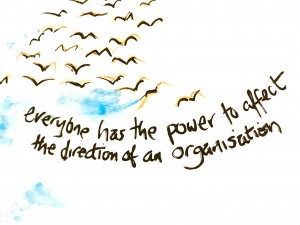Everyone has the power to affect the direction of an organization
Presentation by Annelieke Verkerk (BEING AT Full Potential) at the 19th International Conference on Knowledge, Culture, and Change in Organizations, University of British Columbia, Vancouver 21 -22 February 2019
Introducing the White Paper on CONSCIOUS CULTURE: raising consciousness within organizations and other eco-systems as the pathway for outstanding performance, by Peter Leong, in collaboration with Sujith Ravindran and Mark Vandeneijnde
I. WHAT ARE WE WITNESSING?
Recently, nursing staff at a medium size Dutch hospital put their heads together on the patient intake and registration process, and came up with simplifications that would save them 15 minutes per patient – without compromising on the essentials. In essence they challenged the current culture and – by applying their awareness and professionalism – weeded out unnecessary steps, and created more time for the patient. And what is more, recently on LinkedIn the Dutch Minister for Medical Care applauded the nursing staff for their initiative, commitment and professional attitude.
After so many years of investing in systems, rules and regulations, putting the work floor professionals at the steering wheel heralds a much welcomed culture change in Dutch health care. A change in culture that is now being adopted and supported at the highest levels of government.
“One swallow does not make a summer” but indeed, this example shows: Everyone has the power to affect the direction of an organization.
What are we witnessing in this example? A shift from a systems-centric to a more human-centric approach? From reactive to proactive behaviour? From top down rules and regulations to an appreciation of bottom-up professional attitudes? A culture change in the making? Is this trend also emerging in other organizations?
II. WHY INVEST IN CULTURE CHANGE?
In this increasingly fast-paced and complex “VUCA” world, today’s leaders cannot ignore culture anymore. More and more, leaders understand that they must transform their organizational culture to achieve their long-term strategic goals and vision. For instance, by stepping out of the default response of introducing more systems and control, and consciously favouring and nurturing the Human factor. Ultimately it’s people who will be the source of change and transformation.
Research on organizational culture found that “84 percent said that the organization’s culture was critical to the success of change management, and 64 percent saw it as more critical than strategy or operating model.” Survey by Katzenbach Center – quoted in a Strategy + Business Article; June 6, 2014.
“Culture eats strategy for breakfast”! Attributed to Peter Drucker
Whether we call it showing up authentically, “walking your talk”, or Doing from Being, all organizations and eco-systems benefit from a culture of empowered people, in leadership positions and on the work floor. And as there is a trend in society towards more Lean, Agile, Kaizen and Exponential organizations, the more imperative it becomes that people and teams in those organizations function at Full Potential.
However, the following diagram shows that the bulk of current Learning and Development spending goes towards systems, structures and management tools.
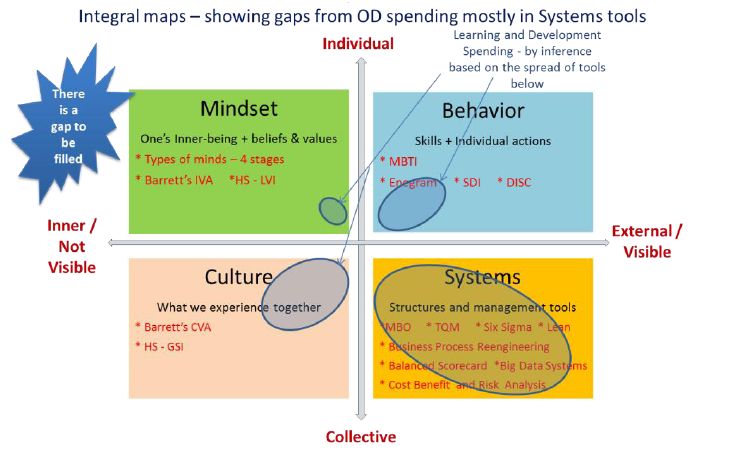
III. WHY IS CULTURE CHANGE SO DIFFICULT TO ACHIEVE?
Basically there are two factors at play here:
- The invisible nature of culture. The culture of an organization is formless. It emerges as the sum of all the people working there – now and in the past – and all the learnings – integrated or not – that are linked to ways of working and/or to impactful events in an organization’s history. These give rise to a system of beliefs, values and behaviours that have come to be taken for granted and eventually drop out of awareness.
- Dealing with people can be messy. Leaders are afraid to rock the boat. Structures, systems and processes are easier to manage, but often give a false sense of control. Deep culture change requires diving deeper into the messy human dimensions and dynamics. If you only tackle the visible and physical elements, basically the deeper layers of Human experience are being ignored and you will not get the results you want.
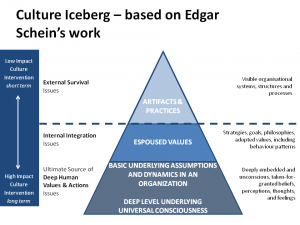
Culture is like an iceberg. In the (adapted) Culture Iceberg of Edgar Schein, the top of the iceberg contains the Artifacts and Practices. Those are the visible elements above the waterline, such as systems, structures and processes. According to Schein, these have to do with External Survival Issues.
The middle layer is about the Espoused Values, the established norms, adopted values and behaviour patterns in an organization. These have to do with Internal Integration Issues.
In the bottom layer are the Basic Underlying Assumptions and Dynamics, the deeply embedded and unconscious, taken-for-granted beliefs, perceptions, thoughts, feelings and dynamics. These feed and interact with the espoused values of the middle layer of the iceberg, and influence the visible outcomes and actions at the top of the iceberg.
At Being at Full Potential we are especially interested in and able to access – through our frameworks and methodology – that deepest level of the Culture Iceberg, the Deep Level Underlying Consciousness. When that is harnessed, a lasting change in culture can be achieved and sustained.
IV. HOW TO GO ABOUT FACILITATING LASTING CULTURE CHANGE?
“WHEN WE ENTER INTO PEAK EXPERIENCE, PEAK PERFORMANCE INEVITABLY FOLLOWS.”
That is not just a slogan. For us and the people that we have worked with, this is a felt experience.
In his White Paper on Conscious Culture, Peter Leong concludes that raising awareness and consciousness is the new change-lever for culture transformation.
http://www.beingatfullpotential.com/community/articles/
He lays out a comprehensive framework and a concrete roadmap that will make life easier for those executives and culture change leaders who want to transform organisational culture in a safe, impactful and powerful way.
How to go about creating a conscious culture?
For deep and lasting culture change, the whole Culture Iceberg needs to be addressed. The bottom layer of the iceberg is crucial, because it is here that the ultimate source of deep human values and actions lies. Peter Leong goes on by showing that there is a way of working with that invisible layer that enhances the psychological safety of the team. As a recent Google study has shown, psychological safety is a key element for unleashing Human Potential.
The Being at Full Potential assessment tools, analytics and methodology address the whole Iceberg, and open up a pathway to the immense and untapped Human Potential of every human being in the organization. We are not aware of any other proven method to address that invisible part of people’s performance at the deepest level.
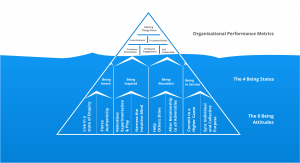
Let’s look at the B@FP Iceberg in more detail. At the top layer – above the waterline – are the 6 Organizational Performance Metrics, that assess behaviours at the level of enterprise performance. That is organizational behaviour that we can observe.
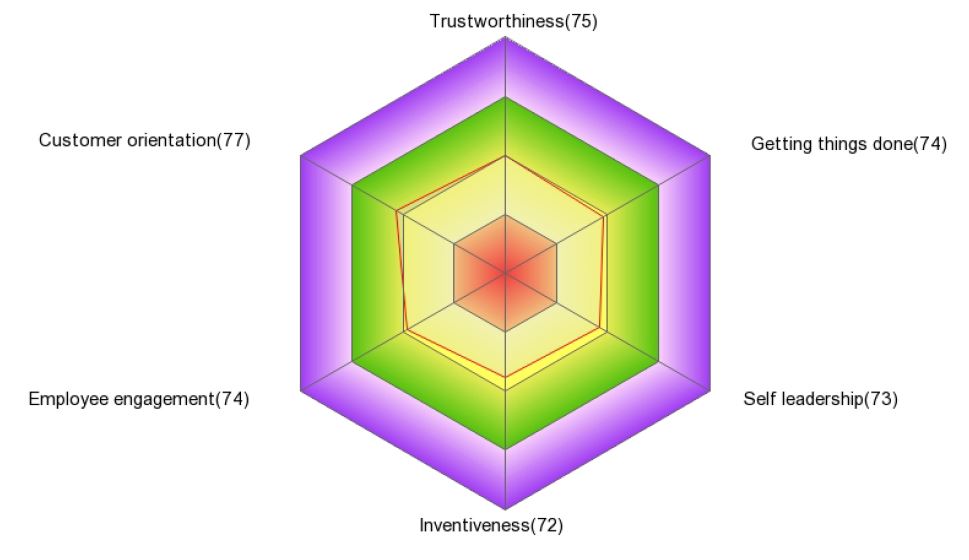
The middle layer of the B@FP Iceberg – under the waterline – deals with mindsets or Being States. The 4 Being States are divided in 23 dimensions, and these make it possible to look at where the team or organization stands. These 23 dimensions contribute to an exploration of what the espoused values are in an organization. It is now possible – and that is a really new and innovative approach – to examine the prevailing values in an organization through the lens of these dimensions. Values need to be revealed. Facilitating conversations in an organization to that effect is a powerful way to getting more awareness on the espoused values. And in this process clarity will emerge on which dimensions can act as levers in light of where the organization wants to go. The Team and Organizational assessments uncover these levers and our Human Potential methodology provides the necessary steps and the psychological safety for a ‘deep dive’ Discovery process, right into those Human dimensions and dynamics.
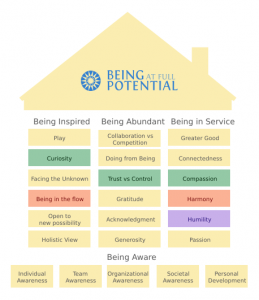
The “House” is a more elaborate representation of the middle layer of the Iceberg.
At the deepest bottom layer it is WHO we are BEING that informs our values and our actions.
The 8 BEING Attitudes, modelled after Being Leaders like Gandhi, Mandela, Martin Luther King and Abraham Lincoln, make the unconscious conscious. What made people like Mandela or Gandhi legendary was their ‘inner state’, going beyond the ‘doing’ to master the realm of true ‘Being’.
All 8 BEING Attitudes are connected and feed each other. Being intentional about practicing the 8 Being Attitudes, exercising them as muscles that can be trained, will enhance your felt experience, helping you to access, maintain or return to higher states of awareness and expanded consciousness.
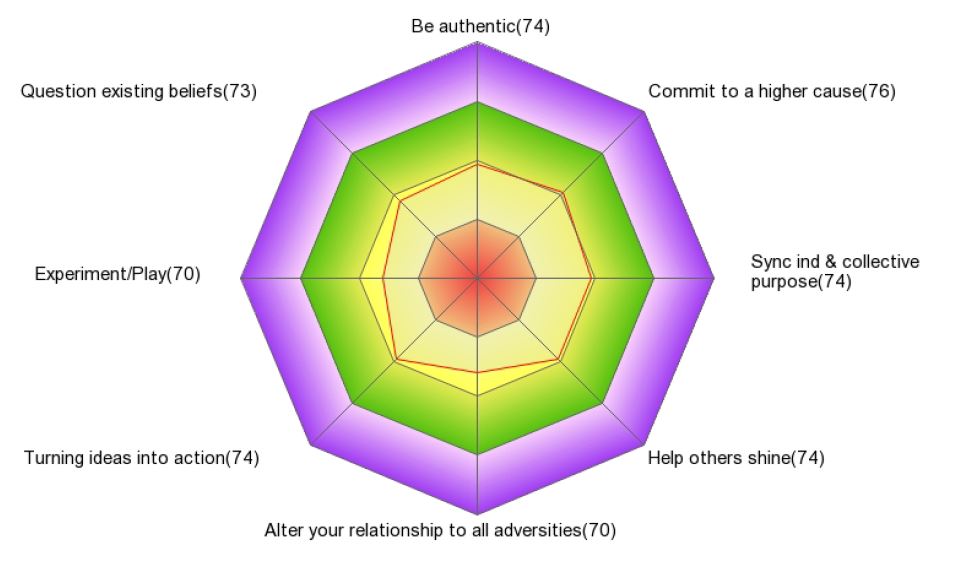
Attitudes drive values and values in turn drive attitudes, sparking a deepening interplay between the bottom and the middle layer. And as behaviour stems from values, if at the bottom layer of the Iceberg you shift the attitudes, you are able to influence the values (middle layer) and behaviours (top layer) of people in an organization in a sustainable way and open a pathway to lasting culture change. At Being at Full Potential we have developed a repeatable way to raise individual and collective consciousness and we know how to create that ‘safe space’ to facilitate conversations and start new narratives at all three levels of the Iceberg. Culture is the result of the combined consciousness. Operating consistently from this deep space will lead to real and profound culture change.Culture change cannot be sustained top down. It is from the deepest layer of the Iceberg that sustainable and thrivable change can come about. And it is the accomplishment of the Being at Full Potential methodology that a way is found to navigate this invisible field.
Only addressing the whole Iceberg, the bottom layer included, will create a Conscious Culture of growth and empowerment where sustained breakthroughs in performance and results can truly take place.
Back to the Dutch nursing staff: What are witnessing in this example in terms of the 8 BEING Attitudes?
Can you recognize some BEING attitudes are at play here? Can you see that the nursing staff are committed to a higher cause and showing up in fierce authenticity in order to put the patient first and create more time for meaningful interaction? Can you see that they are changing their relationship to the adversity of the dominance of systems and regulations by doing something about it? Can you see that they have accessed a state of enquiry that opens them to other possibilities? Can you see that a certain element of experimentation and play is instrumental in pulling this off?
So what would open up if people, teams and organizations would consciously invest in those BEING attitudes? Exercise them as muscles that can be trained? This can be done! And in doing so, you are investing in the bottom layer of the Iceberg and laying the foundation for lasting culture change, right up to the top layer where behaviour is expressed.
V. WHAT IS CONSCIOUSNESS?
And now for the ultimate question: What is Consciousness?
Many people have pondered and meditated on this question and it is only by approximation that one can come up with some kind of answer. For me the following poem of Rilke is a metaphor for this process that also links to the question of Who we are:
“I live my life in widening circles
that reach out across the world.
I may not ever complete the last one,
but I give myself to it.
I am circling around God, around the
ancient tower, and I have been
circling for a thousand years, and I
still don’t know if I am a falcon, or a
storm, or a great song.”
Rainer Maria Rilke
VI. THE CONSCIOUSNESS MATURITY INDEX
Even though the question what consciousness is, remains open for contemplation, fortunately there is a framework that can shed some light on where an organization is in terms of consciousness or awareness. Another way of looking at the sources of deep human values and actions is through the lens of the Consciousness Maturity Index.

The 5 States of Awareness have been adapted from the 5 Kosha’s (or layers of Being) that lie at the foundation of Indian spiritual sciences. These are a well of ancient wisdom that have inspired many great thinkers, amongst others A. Maslow and C. Jung, in their ground-breaking work.
The Consciousness Maturity Index measures the level of consciousness (or maturity) of an organization at a given point in time and indicates how the collective culture may grow into the next stage of maturity. Having a clear picture of the future state makes it easier for organizational leaders to consciously adopt the corresponding management style to communicate a new vision and enrol others behind it.
The Consciousness Maturity Index can function as a road map for unlocking Human Potential by strengthening the Being. For it is in States 4 and 5, the states of unconditioned and transcended awareness that the FULL Human Potential of individuals, teams and organizations and their full capacity for creativity and innovation are unleashed. That is where the Magic happens….
Where would you situate the nursing staff in this framework?
Ken Wilber talks about ‘evolutionary consciousness’. He mentions that understanding of evolutionary consciousness is perhaps the most important thing lacking in awareness practices today. And this is a very relevant observation if one wants to understand and tune in to what is possible in terms of breakthroughs in organizations:
“Evolution means growth and development. This means that there are aspects of reality that have not yet arisen in our consciousness. But they will arise if we grow.” Individually and as a group, in organizations and in society at large. For instance accessing and living into the new paradigm of our “shared humanity” instead of coming from fear and division, or embodying “oneness as the new default mode”. These are some crucial “State 5 awareness” breakthroughs that have emerged from Discovery processes that we have facilitated.
VII. HOW TO HARNESS CULTURE?
Any change at the external level starts with a change at a personal level. This inside-out approach is the essence of the Human Potential methodology.
In order to harness the Full Potential of people in an organization, introducing new language is a powerful medium. We can also introduce new rituals and practices, choose powerful symbols to further bring the new culture to life and learn to mark and celebrate transitions.
Introducing the practice of re-centering, for instance, can make a whole lot of difference. Tuning inwards at the beginning of each meeting, just taking a moment to connect with your inner Being and with the higher purpose of the meeting, can already have such a powerful impact.
For: “WHEN THE BEING COMES ALIVE, THE DOING THRIVES”
This simple practice of re-centering is a powerful way of harnessing the bottom layer of the Iceberg. I know of a couple of organizations who have taken this up at the start of every meeting, and the difference in terms of self-leadership, inventiveness and bottom line results is tangible.
To quote Ken Wilber: “Whenever we moderns pause for a moment, and enter the silence, and listen very carefully, the glimmer of our deepest nature begins to shine forth, and we are introduced to the mysteries of the deep, the call of the within, the infinite radiance of a splendour that time and space forgot.”
It is in accessing this awareness that Consciousness becomes a felt experience. And that is as good as it gets.

